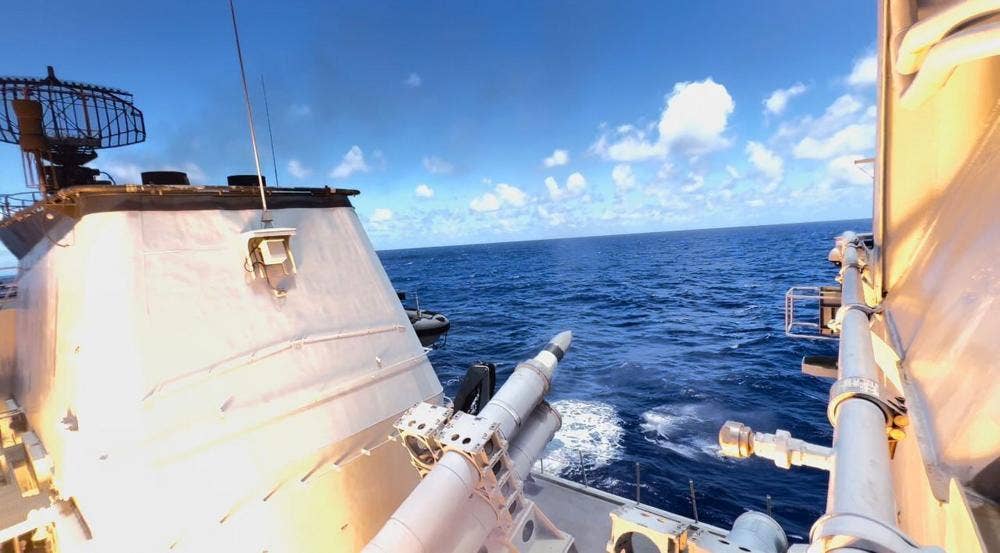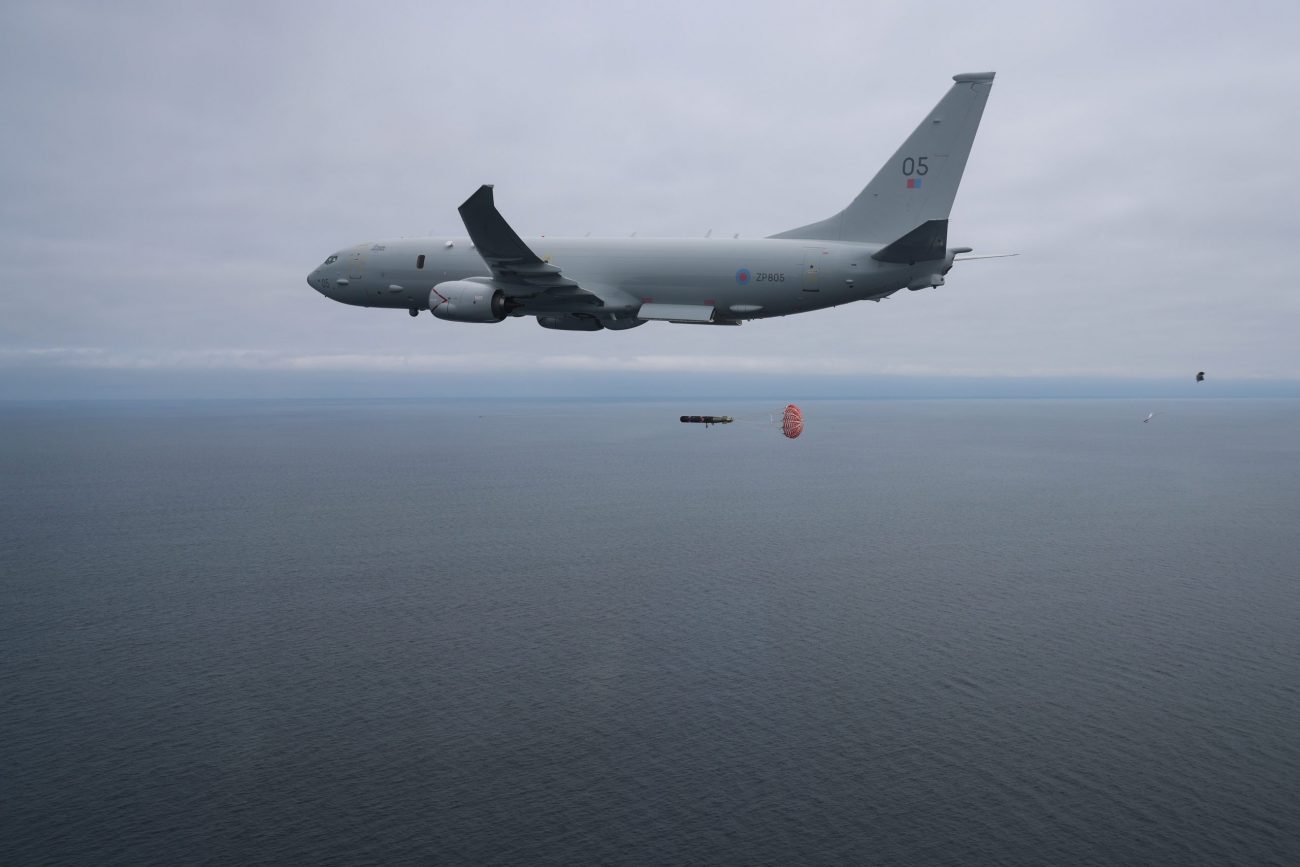The US Navy released a sensational video of a sinking exercise (SINKEX) on July 12, 2022, during the sea phase of Rim of the Pacific (RIMPAC) 2022.
Perturbed By 2nd ‘Incursion’, China Warns US ‘Not To Play With Fire’ & Cancel Arms Deal To Taiwan
‘Sub-Launched UAVs’ – Iran Displays Staggering Drone Power Amid Biden’s Visit To The Middle East
The video shows a decommissioned Oliver Hazard Perry-class guided missile frigate, ex-USS Rodney M. Davis (FFG 60), sunk in waters 15,000 feet deep, about 50 nautical miles (92.6 kilometers) north of Kauai Island in Hawaii.
Named after the Vietnam War hero, Marine Sgt. Rodney Maxwell Davis, the frigate, served the US Navy for 28 years after being commissioned in 1987. It was the first Navy ship to be commissioned in honor of a Black Medal of Honor recipient.
The frigate was decommissioned in 2015 and was reportedly considered for donation to Ukraine in 2018 for deployment in the Black Sea region and possibly even around the entrance to the Sea of Azov.

Instead, it was sunk on July 12 by a salvo of bombs and missiles fired from the ships and combat aircraft of the US, Canadian, Australian, and Malaysian forces, as seen in the video.
This was the latest Oliver Hazard Perry-class frigate to be sunk after the ex-USS Vandegrift (FFG 48) that was sunk off Guam in June, at the end of exercise Valiant Shield 2022, as per a previous EurAsian Times report.
Russia Shoots Down Its ‘Brand New’ Sukhoi Fighter Jet While Conducting Raids Over Ukraine — Reports
Decommissioned Frigate
In the video, the Royal Canadian Navy Halifax-class frigate HMCS Winnipeg (FFH-338), Royal Malaysian Navy Kasturi-class frigate KD Lekir (F-26), and a US Navy P-8 Poseidon maritime patrol aircraft can be seen firing anti-ship missiles to sink the former USS Rodney M. Davis (FFG 60).
The Winnipeg and the Poseidon fired Harpoon anti-ship missiles, and the Lekir fired a French-made Exocet Block 2, which it had also fired in May 2022, during Malaysia’s largest exercise, Taming Sari 21/2022, in the north of the Strait of Malacca.
However, this was the first time an RMN ship fired a missile outside Malaysian waters.

“The SINKEX was a professionally enriching experience for the crew of KD Lekir,” said Adm. Mohd Reza Mohd Sany, Chief of the Royal Malaysian Navy. “These events provide an excellent platform toward enhancing interoperability amongst the participating navies.”
Apart from the sinking of the frigate, there are other videos released by the US Third Fleet showing US Navy F/A-18E/F Super Hornets and Marine Corps F-35C Lightning II, assigned to the Carrier Air Wing 9, taking off from the Nimitz-class aircraft carrier USS Abraham Lincoln (CVN 72).
The F-18s can be seen armed with Paveway laser-guided bombs. While it is unclear what ordinance the F-35C used, it reportedly had the externally mounted GAU-22/A 25mm four-barrelled Gatling gun pod that carries 220 rounds of ammunition and can fire at a ‘full rate’ of 3,000 rounds per minute.
In addition, an MH-60 Seahawk maritime helicopter was also seen taking off, armed with an AGM-114 Hellfire missile.
Resilience To Attacks
The former Rodney M. Davis can be seen remaining afloat even after several hits, though it was engulfed in flames and clouds of smoke.
This was because of the absence of combustible substances aboard the ship, such as fuel, ammunition, etc., that would otherwise lead to secondary explosions. All the compartments inside the vessel were sealed to make it more resilient, according to The Warzone.
The Warzone also pointed out that there was “no crew for damage control efforts to mitigate the ship’s injuries” while noting that the video, to some extent, misrepresented the severity of such types of attacks.
Distributed Lethality
This was the 28th edition of the biennial RIMPAC exercise, which saw participation from 26 nations, 38 surface ships, four submarines, nine national land forces, more than 30 unmanned systems, approximately 170 aircraft, and more than 25,000 personnel.
The exercise theme focused on skills and capabilities that would enable a “distributed, more survivable, more lethal force that’s harder to target,” said the head of the US Pacific Fleet, Admiral Samuel Paparo, on July 9 after a RIMPAC press conference.
The US military is increasingly moving toward the concepts of distributed lethality. Therefore this year’s RIMPAC exercise incorporated a lot of unmanned live-fire capabilities, according to Paparo, “so that shooters are not necessarily tied to sensors and that weapons are receiving sensor data from multiple sources across multiple spectra.”

Paparo further said that the changing nature of warfare with the advent of precision strike technology and the proliferation of sensors from the seabed to space is also driving the American allies and partners toward similar concepts as they realize the increasing importance of mobility and survivability.
Several Asian media outlets asked Paparo whether the RIMPAC had any message for China or North Korea. In response, he expressed concern about the growing combat power of China aimed at power projection beyond its borders and shores.
However, he made it clear that “RIMPAC itself is not oriented against any particular nation-state actor,” while adding, “but it does demonstrate the solidarity of all its participants to the international rules-based order and the principles of sovereignty, of freedom of the seas, of the United Nations Convention on the Law of the Sea, and against what otherwise would be expansionist activities.”
- Contact the author at tanmaykadam700@gmail.com
- Follow EurAsian Times on Google News




